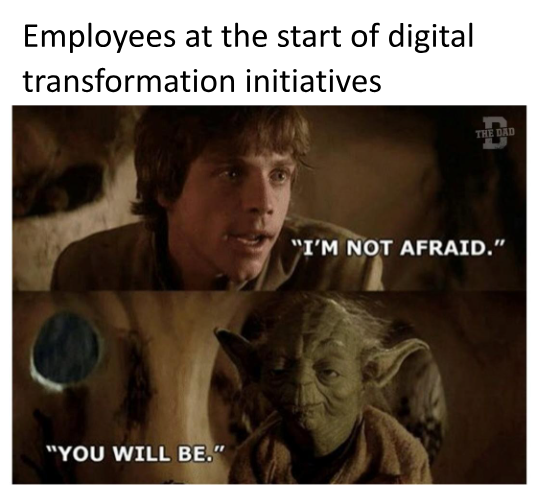You aimed for digital transformation, but instead, you encountered significant cultural challenges.
Like ‘synergy,’ the term ‘digital transformation’ has become another frequently used buzzword in business language. This word sparkles and shines alluding to big, expensive, revolutionary, and awesome change in an organization.
When you mention this in a meeting, people think of various things depending on their role—marketing might envision a new website, sales might think of CRM, engineering might consider a new database, and others might focus on process automation.
These changes are a must to maintain growth and uncover opportunity, reduce labor and transactional costs, and to remain relevant and a leader in your marketplace. The technology ecosystem you manage and nurture directly impacts your business and benefits your team when managed correctly.
BUT
The fundamental problem with digital transformations being executed successfully is not necessarily to do with the technology being implemented, although it is important to clearly identify and choose platforms that are right for you (a discussion for another time).
In our 25 years of experience, we have found that digital transformation often fails or becomes extremely difficult because:
- The initiative is not championed by everybody in the c-suite that clearly can articulate the why and benefits of the initiative.
- Misunderstanding that this is, at its core, a cultural change wrapped up in the guise of a technology transformation.
- Digital transformation is cultural transformation.
MIT Sloan Management Review correctly stated: ‘Few business leaders fully understand how a company’s culture changes during a digital transformation — and, more importantly, how it doesn’t change.
Eyes Wide Open: This is not a frictionless event
In fact, it will be a highly revealing process that exposes unknown problems in your organizational structure, misaligned roles, individuals who should not be in your company, missed opportunities, and unrecognized risks.
I remember my late, good friend, Jeff Bone ending a meeting with a company C-suite that decided to proceed with a bevy of digital initiatives to upgrade and transform their technology. Everybody would be closing their binders, moleskine notebooks, and closing their laptops and Jeff would say,
“There is one more thing we need to discuss”
Of course, everyone would look up interrupted from their departure rituals and look quizzically at Jeff wondering “What now, we just finished a marathon meeting. Let’s go.”
But Jeff waited at the end for this important moment when folks were anxious to go somewhere on purpose.
He would ask one question,
“Do you have patience?”
You see, digital transformation is not a project, not a single implementation, not a new subscription service, new re-engineered processes, etc.
Digital transformation is at its core a fundamental change in how an organization operates, relates, understands, and communicates.
And this change is hard for humans.
We get comfortable with our ways of doing things. Positions of security in an organization where you sit on some domain controlling infrastructure, information, processes, etc. We don’t like our routine interrupted or altered or even, possibly, automated into elimination.
All this change generates a whole lot of fear in some folks. And as Yoda so rightly states, “Fear leads to anger, anger leads to hate, and hate leads to suffering.” In this case your company and especially your leadership will feel that friction.
This fear leads to team members becoming contentious and non-collaborative when they are looking to bend the transformation back to their needs and security. It can, and has (I’ve seen it first hand) to lies, shouting matches, and threats.
Fear is not all bad, but in my experience it gets magnified for some during these initiatives.

And I am dating myself now, we don’t like our cheese moved. In Spencer Johnson’s excellent book “Who Moved My Cheese?” (that stands up to time) he nails it on the head “..some fear can be good. When you are afraid things are going to get worse if you don’t do something, it can prompt you into action. But it is not good when you are afraid that it keeps you from doing anything.”
How do you maintain the course in digital transformation?
- The C-Suite must be on board with the digital transformation and championing them throughout the process.
- The C-Suite must clearly state the WHY of the digital transformation and enumerate in clear, simple language the benefits. And where possible define the benefits in metrics, as in, we will move from this current metric X to Y metric.
- Be transparent, honest, and set expectations. Let folks that to get from point A to point B will cause friction and to not be surprised by it. It will deflate the angst and fear for many when you hit that roadblock you can say, “Hey, we discussed that we would experience this. This is normal.”
- Patience must be exercised in the process of change as it will often encounter obstacles unknown prior to the start and encounter opposition throughout the roadmap implementation.
And be patient with those detractors that oppose, slow-down, thwart, and become a general pain-in-the-transformation. They need to be coached on the why and benefits. They need to be brought along until either they get on the proverbial Good to Great Bus of Jim Collins or exit at that next bus stop.
Keep your eye on the prize
It’s not all easy, but it is important and valuable work. Keep focused on the objective of moving your company, team, organization, etc. to the next level.
Keep articulating to yourself and your team the future state we are all looking to reach.
You will get there, but have patience and maintain focus.
CONTACT US to help those transformation goals move forward!




Recent Comments